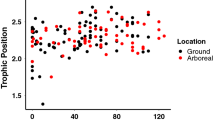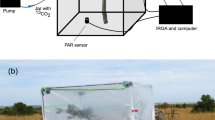Abstract
An obligate symbiosis between Ocotea dendrodaphne Mez and O. atirrensis Mez & Donn.Sm. (Lauraceae) and their cryptic ant symbiont, Myrmelachista flavocotea, is common in lowland wet forests of Costa Rica, yet it is unclear whether the association is typically mutualistic or parasitic. Ants impose costs by tending trophobionts inside the plant body and further compromise the structural integrity of their host by hollowing its stems. Benefits to the host, including anti-herbivore defense and nutrient provisioning, must outweigh these costs for the association to be mutualistic, but benefits in this system are largely unknown. We adopted a stable isotope approach to investigate trophic relationships among Ocotea hosts, coccoid trophobionts, and worker and larval ants in the understory of mature forest at La Selva Biological Station, Costa Rica. In addition, a natural stable isotope marker (tuna) was made available to M. flavocotea colonies to determine whether ants are fortuitous scavengers and/or provision their host. In this system, we found unusual patterns of isotopic fractionation. For coccoids, nitrogen isotopes are only slightly enriched, and carbon isotopes were depleted relative to the host signature. Moreover, nitrogen signatures of the timid Myrmelachista ants are high, suggesting a substantial degree of carnivory and/or scavenging in this species. In the provisioning study, ant colonies provided with baits demonstrated a significant shift in carbon isotopic composition relative to untreated colonies indicating uptake and assimilation of the bait. These results suggest that these timid ants are patrolling the plant for food and concentrating nutrients in Ocotea’s hollowed stems. Further studies are required to confirm if M. flavocotea provides a net benefit to its host by providing nutrients, reducing herbivory, or by removing detrimental debris from the plants surface.


Similar content being viewed by others
References
Blüthgen N., Gebauer G. and Fiedler K. 2003. Disentangling a rainforest food web using stable isotopes: dietary diversity in a species-rich ant community. Oecologia 137:426–435
Bronstein J.L. 1998. The contribution of ant-plant protection studies to our understanding of mutualism. Biotropica 30: 150–161
Davidson D.W., Cook S.C., Snelling R.R. and Chua T.H. 2003. Explaining the abundance of ants in lowland tropical rainforest canopies. Science 300: 969–972
DeNiro M.J. and Epstein S. 1981. Influence of diet on the distribution of nitrogen isotopes in animals. Geochim. Cosmochim. Acta 45: 341–351
Ehleringer J.R., Rundel P.W. and Nagy K.A. 1986. Stable isotopes in physiological ecology and food web research. Trends Ecol. Evol. 1: 42–45
Fischer R.C., Richter A., Wanek W. and Mayer V. 2002. Plants feed ants: food bodies of myrmecophytic Piper and their significance for the interaction with Pheidole bicornis. Oecologia 133:186–192
Hammel B.E. 1986. The vascular flora of La Selva Biological Station, Costa Rica-Lauraceae. Selbyana 9: 218–233
Herre E.A., Knowlton N., Mueller U.G. and Rehner S.A. 1999. The evolution of mutualisms: exploring the paths between conflict and cooperation. Trends Ecol. Evol. 14: 49–53
Hobson K.A. and Welch H.E. 1992. Determination of trophic relationships within a high Arctic marine food web using stable-isotope analysis. Mar. Ecol. Progr. Ser. 84: 9–18
Hölldobler B. and Wilson E.O. 1990. The Ants. Harvard University Press. Cambridge, Massachusetts, USA. 732 pp
Izzo T.J. and Vasconcelos H.L. 2005. Ants and plant size shape the structure of the arthropod community of Hirtella myrmecophila, an Amazonian ant-plant. Ecol. Entomol. 30: 650–656
Lapola D.M., Bruna E.M. and Vasconcelos H.L. 2003. Contrasting responses to induction cues by ants inhabiting Maieta guianensis (Melastomataceae). Biotropica 35: 295–300
Letourneau D.K. 1983. Passive aggression: an alternative explanation for the Piper-Pheidole association. Oecologia 60: 122–126
Letourneau D.K. 1998. Ants, stem-borers, and fungal pathogens: experimental tests of a fitness advantage in Piper ant-plants. Ecology 79: 593–603
Longino J.T. 2006. A taxonomic review of the genus Myrmelachista (Hymenoptera: Formicidae) in Costa Rica. Zootaxa 1141: 1–54
McDade L.A. and Hartshorn G.S. 1994. La Selva: Ecology and Natural History of a Neotropical Rain Forest. University of Chicago Press, Chicago. 486 pp.
O’Dowd D.J. and Hay M.E. 1980. Mutualism between harvester ants and a desert ephemeral: seed escape from rodents. Ecology 61: 531–540
Rico-Gray V. and Oliveira P.S. 2007. The Ecology and Evolution of Ant-Plant Interactions. University of Chicago Press, Chicago. 331 pp.
Sagers C.L. and Goggin F. 2007. Isotopic enrichment in a phloem-feeding insect: effects of nutrient and water availability. Oecologia 151: 464–472
Scrimgeour C.M, Gordon S.C., Handley L.L. and Woodford J.A.T. 1995. Trophic levels and anomalous δ15N of insects on raspberry (Rubus idaeus L.). Isotopes in Environmental Health Studies 31: 107–115
Stout J. 1979. An association of an ant, a mealy bug, and an understory tree from a Costa Rican rainforest. Biotropica 11: 309–311
Thompson J.N. 2000. The Coevolutionary Process. University of Chicago Press, Chicago. 376 pp
Thompson J.N. 2004. The Geographic Mosaic of Coevolution. University of Chicago Press, Chicago. 443 pp
Tillberg C.V., McCarthy D.P., Dolezal A.G. and Suarez A.V. 2006. Measuring the trophic ecology ants using stable isotopes. Insect. Soc. 56: 65–69
Vasconcelos H.L. and Casimiro A.B. 1997. Influence of Azteca alfari ants on the exploitation of Cecropia trees by a leaf-cutting ant. Biotropica 29: 84–92
Wagner D., Brown M.J.F. and Gordon D.M. 1997. Harvester ant nests, soil biota and soil chemistry. Oecologia 112: 232–236
Yoneyama T., Handley L.L., Scrimgeour C.M., Fisher D.B. and Raven J.A. 1997. Variations of the natural abundances of nitrogen and carbon isotopes in Triticum aestivum, with special reference to phloem and xylem exudates. New Phytol. 137: 205–213
Acknowledgments
We owe thanks to E. Pollard and T. Millican of the UASIL for assistance with stable isotope analyses, J. Ludlam and D. Magoulick for statistical advice, V. Carmona and the class of OTS 01-1 for help with field collections, T. Kondo for identifying mealy bugs, D. McClearn for logistical support, Organization for Tropical Studies for use of La Selva Biological Station and facilities, and classmates of The Evergreen State College, 2006. Funding for this project comes from an Undergraduate Research Award from the University of Arkansas Honors College to KP, an OTS Glaxo Wellcome Fellowship to PB, and National Science Foundation grant DEB-0640015 to JTL. A portion of this work was completed while CLS was a fellow of the National Research Council at the US EPA/NHEERL/WED laboratory in Corvallis, OR, USA. The manuscript was greatly improved by the comments of two anonymous reviewers.
Author information
Authors and Affiliations
Corresponding author
Additional information
Work performed at La Selva Biological Station.
Rights and permissions
About this article
Cite this article
McNett, K., Longino, J., Barriga, P. et al. Stable isotope investigation of a cryptic ant-plant association: Myrmelachista flavocotea (Hymenoptera, Formicidae) and Ocotea spp. (Lauraceae). Insect. Soc. 57, 67–72 (2010). https://doi.org/10.1007/s00040-009-0051-z
Received:
Revised:
Accepted:
Published:
Issue Date:
DOI: https://doi.org/10.1007/s00040-009-0051-z




